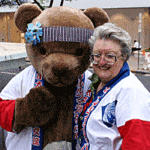Kobuk Valley National Park, Alaska
Kobuk Valley National Park was first designated a national Monument in 1978. It survived that designation two short years before becoming a National Park. Kobuk Valley National Park is located 26 miles north of the Arctic Circle, just south of the Brooks Range of Gates of the Arctic National Park (32 miles away). Nestled between 2 mountain ranges, Baird to the north and Waring to the South, it is a protected circle valley. The landscape varies from birch and poplar forests in the lowlands, to tundra, (typical of the parklands north of the Arctic Circle), and its main featured identity, sand dunes.
There are three sets of sand dunes within the park, the Great Kobuk Sand Dunes, Little Kobuk Sand Dunes and Hunt River Sand Dunes. These dunes, towering as high as 100 feet, were created by ancient glaciers grating on the landscape. The fine particles produced drifted in by wind or carried by the rivers and stayed in this protected valley, forming an absolutely awesome sight. Of course, there are no roads here, and there are no designated trails. Yet, there is evidence of man occupying the area as long ago as 12,000 years.
The nomad of the north (Caribou), migrate through here in August in vast quantities of up to half a million. This has formed an attraction for man to capitalize on concentrated prey. Especially in the Onion Portage area, the site the caribou use to ford the river. They also attract other predators, like bear, both black and brown (grizzly), wolves, wolverines, fox and eagles. All prey on the calves. Some, like the stalking wolves prey on larger members of the herd. Other animals in the area are moose (recent migration), dall sheep in the higher altitudes (highest is 4,750 feet), and an assortment of migrating birds.
There are three main rivers within the park’s 1.7 million acres, The Kobuk, the Salmon and the Tutuksuk. Three species of salmon — Chum, King and Pink — are present in the parks rivers and streams. Seventy five miles to the Northwest lies the Chukchi Sea, where Kobuk River empties into the ocean. Two thirds of the river are within the park boundaries and it is wide and slow moving. Willow trees are found near the rivers and lakes edges. At one time the river was not so placid and that is part of what created this natural phenomena.
There are 17 archaeological sites within the park which predate European settlements. And most have not been explored or investigated very thoroughly. The sites reside on native settlement land. The local population are Kuuvangmiit, which live in 3 main villages within the park. There are 94 acres of cemetery and/or historical sites in total.
With no roads (something you haven’t heard before?) the only way in, besides backpacking, is by plane. Bush pilots fly in from Kotzebue or Nome and land on the very top of the sand dunes! When you get out of the plane, there are no other footprints or tires tracks in the sand, and you feel like you just dropped onto a foreign planet (uninhabited of course). And a beautiful sight to see with more than 25 square miles of golden sand stretching out before and around you.
You can spend a short stay here or chose to camp and fish. Truly part of the wild and wonderful Alaska.




